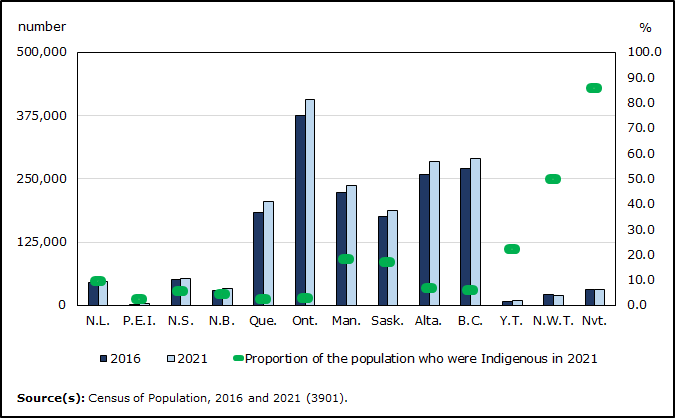Infographic 1
Most Indigenous people live in Ontario and Western Canada, but account for larger share of overall population in territories

Infographic description
The title of the infographic is "Most Indigenous people live in Ontario and Western Canada, but account for larger share of overall population in territories"
This is a bar chart with a second vertical axis and tick marks.
The vertical axis on the left shows the number of Indigenous people for each province and territory, in 2016 and 2021, in numbers from 0 to 500,000 in intervals of 125,000. The vertical axis on the right shows the proportion of the total population who were part of the Indigenous identity population in 2021, for each province and territory, in percentages from 0.0 to 100.0 in intervals of 10.0.
The horizontal axis shows each province and territory in Canada.
The first series of bars shows the number of Indigenous people in each province and territory for the year 2016: there were 45,725 Indigenous people in Newfoundland and Labrador; 2,735 in Prince Edward Island; 51,495 in Nova Scotia; 29,385 in New Brunswick; 182,885 in Quebec; 374,395 in Ontario; 223,310 in Manitoba; 175,020 in Saskatchewan; 258,640 in Alberta; 270,585 in British Columbia; 8,195 in Yukon; 20,860 in the Northwest Territories; and 30,550 in Nunavut.
The second series of bars shows the number of Indigenous people in each province and territory for the year 2021: there were 46,550 Indigenous people in Newfoundland and Labrador; 3,385 in Prince Edward Island; 52,430 in Nova Scotia; 33,295 in New Brunswick; 205,010 in Quebec; 406,590 in Ontario; 237,190 in Manitoba; 187,890 in Saskatchewan; 284,465 in Alberta; 290,210 in British Columbia; 8,810 in Yukon; 20,040 in the Northwest Territories; and 31,390 in Nunavut.
The tick marks, corresponding with the right vertical axis, show the following proportions for the year 2021: in Newfoundland and Labrador, 9.3% of the population was Indigenous; in Prince Edward Island, 2.2%; in Nova Scotia, 5.5%; in New Brunswick, 4.4%; in Quebec, 2.5%; in Ontario, 2.9%; in Manitoba, 18.1%; in Saskatchewan, 17.0%; in Alberta, 6.8%; in British Columbia, 5.9%; in Yukon, 22.3%; in the Northwest Territories, 49.6%; and in Nunavut, 85.8%.
Source(s): Census of Population, 2016 and 2021 (3901).
- Date modified: